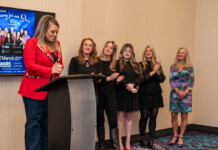

When considering safety factors to adapt your home as you grow older, look for good visibility, excellent lighting, accessibility and no trip hazards. Be sure that your address numbers are clearly visible from the street to aid guests and first responders.
Walkways to doors should avoid trip hazards, such as uneven stones or raised concrete joints. Shrubbery should not interfere with walkways. Outdoor lighting should have sensors that can either detect motion or turn themselves on at dusk and off at daylight. Lighting fixtures should point downward to avoid shadows and should be frosted to help reduce glare.
Stairs should have step risers of equal height with each being about 8 inches high. Sturdy handrails should be 1.5 inches thick on both sides of the stairs and extend beyond the top and bottom steps to provide proper support for approaching or exiting. Steps should be deep enough and wide enough to accommodate the person and a mobility aid. Visual clues provided by proper lighting or color changes help to define each step.
The entrance door should be at least 36 inches wide or able to be that wide with the use of special offset swing clear hinges. The door should swing inward to avoid having to step backward. The entrance door threshold should be flat (zero-step) or no more than a half-inch high. Zero-step thresholds are important to avoid tripping and permit easier access for wheelchairs and walkers.
Note that if you are able to achieve a zero-step threshold, you need to be sure the porch/landing/pathway leading to the door slopes away from the door sufficiently for carry water away from the door to avoid flooding.
The door should have a lever-style handle for ease of use. On the inside, the door should have a security slide chain and a peephole viewing port or a porch/doorbell camera for observing who is outside. Make sure flooring inside and outside the door is slip-resistant. A key lockbox for first responders is a great idea.
A shelf or a chair near the front door can provide a place for a person to rest or put down packages while looking for keys to unlock the door. For some residents, an electronic lock may ease the entry process or provide a back-up when a key is lost or forgotten.
Keep in mind that some entrances may eventually require modifications, such as the ramp or a lift when a person’s mobility becomes more limited, necessitating a safer approach to the entrance. Also, keep in mind that an alternate entrance may be more feasible.
(Source: AARP HomeFit Guide at aarp.org/homefit.)
Ron Smith is a Maricopa resident and an aging-in-place advocate. He is also a member of the Age-Friendly Maricopa Advisory Committee and a member of the Maricopa Senior Coalition.
This column appears in the September issue of InMaricopa magazine.


![Who’s the Best Mom InMaricopa? Nominate now! Marlene Marshall, Christina Olivares, and Meghan Bremer. [Bryan Mordt]](https://www.inmaricopa.com/wp-content/uploads/2023/05/BCM_8465-218x150.jpg)





![Senior Info/Expo draws hundreds Clinical Liason Elaina Young of Compassus Hospice and Palliative Care speaks with an attendee at the Senior Info/Expo at the Maricopa Library and Cultural Center on Jan. 20, 2024. [Monica D. Spencer]](https://www.inmaricopa.com/wp-content/uploads/2024/01/spencer-012024-senior-info-expo-web-01-218x150.jpg)








